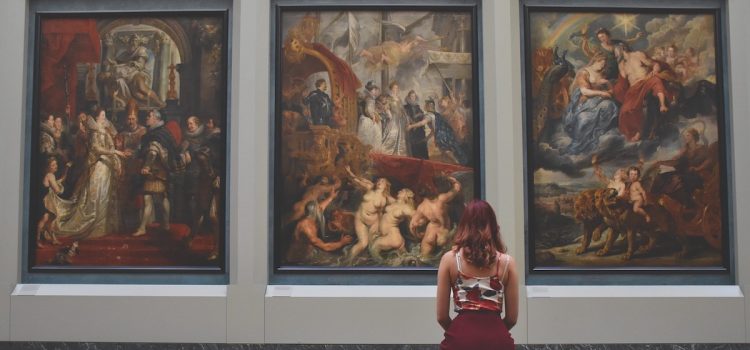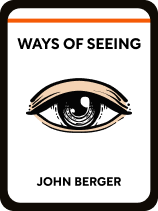

This article is an excerpt from the Shortform book guide to "Ways of Seeing" by John Berger. Shortform has the world's best summaries and analyses of books you should be reading.
Like this article? Sign up for a free trial here .
What makes art an effective form of social commentary? How has art been used to assert social status?
Sometimes art reflects the views of the artist and those who buy the art. That can make art a rather powerful medium. According to John Berger, the author of Ways of Seeing, the way we see art has historically been manipulated by a privileged minority to preserve their social and economic dominance.
Keep reading to learn Berger’s view on how art has been co-opted for social purposes.
Art as Social Commentary
Ways of Seeing is a collection of seven untitled essays, three of which are visual and contain no text. The essays can be read in any order, and while each essay focuses on a different topic, there are connecting themes of perspective (“ways of seeing”) and mystification—essentially how people have used art as social commentary throughout history.
Mystification
Berger uses the term mystification throughout Ways of Seeing, and though there are contextual clues as to the implications of the word, he speaks as if the reader is already familiar and provides only one line of definition: “Mystification is the process of explaining away what might otherwise be evident.” Because this term is used so heavily in the text, we’ve added a breakdown of mystification, from its literal definition to the economic context in which it’s used:
Dictionary definition of mystification: “an obscuring especially of capitalist or social dynamics (as by making them equivalent to natural laws) that is seen in Marxist thought as an impediment to critical consciousness.”
In Marxism, mystification refers to the intentional deceiving of the majority working class (proletariat) by the minority upper/middle class (bourgeoisie) to preserve their wealth. Berger takes this framework of mystification and applies it to the way art is critiqued and owned—particularly the idea that throughout history, art historians and the wealthy elite have obscured ideologies hidden within the art. Though he doesn’t use the term in a strictly Marxist sense, there are clear parallels between the two and it can be inferred that Berger’s Marxist beliefs influenced his perception.
In this context of art and politics, Ways of Seeing challenges the idea that, to understand and appreciate works of art, we need experts to “translate” them for us. Rather, Berger urges us to pull back the curtain and look at the images before us with our own eyes.
What Is an Image?
An object, living being, or landscape that exists before your eyes in real life is a sight. The couch you are about to sit on, the floor beneath your feet, and the flowers you see in the garden outside your window—these are all sights. An image is a sight that has been reproduced or recreated. The sight becomes an image when it is separated from the place and time in which it truly exists (or existed). A painting, a video, even a photograph—these are images.
Berger says that once a sight becomes an image, it’s no longer an exact record of what was. The act of reproducing a sight inherently adds a subjective value to the image. Rather than being a historical record of the sight, it’s now a record of how someone saw the sight … and how you are seeing the image now.
(Shortform note: When an image is continuously reproduced, you might imagine the meaning being skewed each time—similar to the childhood game of Telephone. With each iteration, a nuance is added or a distortion takes place.)
Our Experiences and Beliefs Influence What We See
Berger argues that our beliefs, experiences, and knowledge strongly influence what we see. Imagine three people are looking at the same image of an iceberg. The person who is concerned with climate change will instantly assign a symbolic meaning and see a melting iceberg within a rapidly heating planet. The person who has been to Alaska will see a landscape that is familiar and majestic. The third person, a history buff, will see what caused the sinking of the Titanic. In each case, the belief, experience, or knowledge influences what the person sees.
(Shortform Note: One study found that the amount of context we receive influences how we interpret visual information. Particularly, when there is little to no context, we tend to fill in the blanks ourselves and think more critically. When given context, our brains naturally move toward it (also known as confirmation bias) and we’re less likely to diverge from the information given. This supports Berger’s argument that what we believe influences what we see.)
The European Tradition of Oil Painting
The primary topic Berger discusses in Ways of Seeing is the European tradition of oil painting, which he says occurred between the years 1500 and 1900. The technique of oil painting (mixing pigment with oils to create a medium) was around long before the Renaissance, but it became an art form during this period because, for the first time, there was a need to develop and perfect the technique. This need was primarily due to the subjects being depicted: food, pedigreed animals, expensive objects, land, and so on. Tempera and fresco paintings couldn’t produce the intense realism that oil painting could, so to depict these subjects in a way that essentially placed them in the room—the desired effect—oil painting was necessary.
| Why Oil Paints Are the Best Medium for Realistic Paintings Tempera is an egg-based paint that produces muted colors and dries very quickly. Fresco painting is the process of using watercolor paints on wet plaster, which also dries quickly. In both of these mediums, the artist doesn’t have the luxury of taking his time. He also has less control over the paint and mistakes are difficult to fix. Oil paints, on the other hand, have an extremely long drying time—depending on the solvent used to thin the paint, it can take days, weeks, months, or even years in some cases, to fully cure. This allows the artist to work very slowly and deliberately. The texture of oil paints lends them well to blending, which can produce seemingly infinite shades of color. Unlike other mediums, the colors of oil paints are vivid and saturated, which allow them to be layered on top of one another to create depth and texture, as well as fix mistakes. |
Norms of the Tradition: Oil Paintings as a Depiction of Wealth
Berger argues that European oil paintings from 1500-1900 were almost entirely focused on displaying wealth. He explains that oil painting rose to prominence beginning with the Renaissance largely because of its ability to accurately depict tangible items. This made it an excellent medium for depicting subjects that represent wealth and power:
- Expensive objects
- Feasts
- Pedigreed animals
- Land ownership
- Portraits
- Mythology
- Genre paintings
- Colonization
- Nudes
| The Hierarchy of Genres While all the listed subjects depicted or symbolized power, for some viewers, the genres they represented weren’t created equal. From the 17th century onward, many academics believed in a strict ranking of artistic genres based on their perceived aesthetic and moral value. The first hierarchy of genres was established in 1667 by Andre Felibien, a theoretician of French classicism. He ranked the categories in the following order, from most to least valuable: —History paintings: Paintings with mythological, religious, historical, or literary subjects. The paintings must contain an intellectual or moral message. —Genre paintings: Paintings depicting everyday life. —Portraits —Landscapes —Still lifes |
Expensive Objects
Consider this painting by Holbein. If you look closely at what is being depicted, it oozes wealth. Berger describes to us the materials being displayed: marble, velvet, fur, and silk, among others. The men display their privilege through items like books, globes, scientific tools, and musical instruments—symbols of the educated class.
These men surrounded themselves with their most expensive and class-validating possessions and hired an artist (Holbein) to paint them. And this was the norm. Why? That is the question that Berger urges us to consider.
THE AMBASSADORS BY HOLBEIN 1487/8-1543
| Achieving Texture With Oil Paints Berger describes how Holbein painted the textures of velvet, marble, fur, silk, wood, and metal all in one painting. How is this achieved? Most artists agree that experimentation is the best way to learn about texture. Start by playing with the following factors: Brush stroke: Dabbing, swooping with pressure, lightly sliding, and so on, all produce different looks on the canvas. Viscosity of the paint: For thick texture (impasto), use the paint straight out of the tube with no medium to thin it. For thinner paints, add a solvent, such as turpentine or mineral spirits. Don’t add too much or your paint will become soapy. Dry mediums: Try adding sand, pumice, or glass beads to your paint to add an unexpected texture. Use a pallet knife or disposable brush when applying this, as it can ruin your good paintbrushes. |
Food, Pedigreed Animals, and Land Ownership
Just as expensive objects represent wealth, so did great feasts, expensive pedigreed animals, and ownership of land. These were things that the working class didn’t have, and the wealthy elite who commissioned paintings were proud to have them. Berger says that thousands of paintings from the tradition fell into one of these categories.
(Shortform note: Cornell University conducted a study of more than 750 Western food paintings from the years 1500 to 2000, similar to the years Berger discusses. They added that the foods displayed were often exotic, native to non-Western lands. Fruits were also heavily featured, when in reality vegetables were much more readily available. The study authors warn art lovers to not use these images as a historical record of what was actually eaten at the time; rather, liberties were taken in order to appear as elite as possible.)
Mythology
According to Berger, paintings of ancient myths and religious stories were the most respected category of painting. Because the wealthy elite were educated, they were the minority in society who had access to these myths. But instead of inspiring their wealthy owners to live up to the morality depicted in the paintings, Berger says the paintings instead served only to confirm its owners’ high perception of themselves because they were educated enough to know the stories being told.
Genre Paintings
“Genre” paintings were the opposite of mythological images. Rather than depicting morality and virtue, the genre paintings depicted unrefined vulgarity. The subjects of these paintings were the working class—nameless individuals going about their lives. The genre paintings that follow the tradition depict the working class as poor, but happy. Often, the subject is even smiling outward at the viewer of the painting, presumed to be a member of the bourgeoisie. Berger says this depiction isn’t realistic, but that it kept the wealthy from feeling guilt about their privilege (mystification).
Colonialism
Just as myth paintings assured elites that they too were moral and therefore deserving of their wealth, paintings that depicted colonized people and places reminded elites that (in their view) their culture was superior and therefore justified violent conquest. Berger explains that the painting in itself (a commodity) and the subject it depicted both contributed to this view.
(Shortform note: Postcolonial theory is a body of thought that claims we cannot understand the world we live in without considering how imperialism and colonial rule has shaped it. “Post” is added to the word colonial because it primarily focuses on colonialism from the 18th to 20th centuries, but the theory doesn’t imply that colonialism has ended.)
The Mystification of European Oil Paintings
Because of the subjects depicted in paintings from this time period, as well as the monetary value the paintings hold as commodities, European oil paintings are ripe for mystification. One of the most prominent ways that art is being mystified today is in how it’s represented and explained through art theory and history. According to Berger, the artists and works that are most represented by museum docents and historians don’t accurately reflect the norms of the European oil painting tradition. As a result, the history of the time is invisible to the viewing public, which means they’re unable to learn from it.
The rise of the oil painting coincided with the rise of the free art market in Europe. Almost all paintings during this time were done on commission, in large part because of the expense of the venture. The wealthier a person was, the more paintings he could commission. Because the paintings were commissioned, the patron had control over what the painting depicted. Berger explains that this is a form of mystification, because if you study the paintings from this time period, you are not seeing a record of what was—you are seeing how the wealthiest class of people wanted to be portrayed. These depictions protected their social status, which is inherently connected to wealth, for all of history.
(Shortform note: Berger explains how mystification benefits the wealthy, but he doesn’t provide a clear argument for how demystification of centuries-old paintings would affect modern-day capitalism. We might infer that if the masses were to understand the class stratification and oppression of the past, they might be more likely to recognize it in modern society and challenge its authority.)
Nudity and Objectivity
Nude women were a prominent subject in European oil painting. Berger points out that in the same way oil paintings depicted wealth using images of land and objects, women were also seen as property to be flaunted. Nudes, Berger says, are characterized by the objectification of the female “subject,” who through the assumed gaze of the male viewer is made into an object.
Naked Versus Nude
We can’t know for sure what the subject in an image is feeling, but Berger says there are three primary distinctions between nudes and nakedness that you can visually see in an image:
- The nude is conventionally attractive—the woman’s body is depicted in a way that satisfies man’s desire in a given time period. Nakedness will display “flaws” by conventional standards.
- The nude is present for the purpose of being viewed—she is visibly aware that she is the object of a man’s attention, evident by her eyeline and/or body positioning. Nakedness contains no exhibitionism or voyeurism. The woman is simply living her life as anyone would, which occasionally requires being naked.
- The nude is passive and still—often portrayed lying down in the supine position, the nude is inanimate, just as an object would be. Her face is placid or coy. Nakedness is portrayed using motion and expression—a towel slipping, a woman moving lustfully or appearing surprised, are examples that show that she’s a living human.
When speaking in terms of percentage, Berger explains that nudes are common in European oil paintings, and nakedness is rare. He infers that the rarity exists because the image of a naked woman that doesn’t “belong” to the spectator-owner is not marketable.
(Shortform note: Sir Kenneth Clarke, Berger’s primary adversary, argues that to be naked is to be without clothes and to feel exposed or embarrassed because of it. It’s a vulnerable state of being. To be nude, he says, is intentional and comfortable. A nude represents a particular society’s ideal figure. This means that a nude in one country or one time period will be different than that of another.)
The Impact of Reproduction
The invention of the camera (and therefore a means to reproduce images) forever changed how art was viewed, understood, and appreciated. For the first time in history, art could travel to the viewer, and the viewer could be anywhere in the world. As one form of mystification lifted, room was made for a different sort—the intentional distortion of meaning through physical manipulation of the image.
| Walter Benjamin’s “The Work of Art in the Era of Mechanical Reproduction” Berger notes that his discussion in this section draws heavily on philosopher Walter Benjamin’s essay “The Work of Art in the Era of Mechanical Reproduction.” Benjamin argued that reproduction of art devalues what he calls its “aura,” or its special, noble, meaning-giving power, which is present in the original work. Without connection to its physical place or the special moment-in-time quality of art that makes it timeless, art is open to political co-option. |
Reproduction Removes the Art From Its Intended Home
The original meaning of a painting is distorted each time it’s viewed in a new location. Imagine that you’re viewing a painting of Jesus Christ on a crucifix. You’re standing in front of the original painting in a beautiful cathedral, surrounded by hushed whispers, ornate stained glass, and soaring ceilings. Now imagine you are looking at a replica of that same painting, and it’s hanging on the wall of your grandmother’s living room. It’s reasonable to assume that your reaction (and your interpretation of the work) would differ between the two experiences.
(Shortform note: While smartphones are undoubtedly a way art and music are divorced from place, some artists are using smartphones to create intentional place-based work. Using GPS, a Washington D.C. band created an album that you can only hear if you’re at the National Mall, listening on your phone. If you walk too far away from the Mall, the album won’t play.)
Reproduction Breaks the Whole Into Parts
Before reproduction, paintings were only ever viewed and analyzed in their entirety. After reproduction, paintings could be interpreted based on individual sections. Why would someone display part of a painting rather than the whole thing? Berger explains the motivation: When a person has the freedom to pick and choose which sections of a painting to display, they gain control over the message that it sends. (Shortform note: Modern technology has made cropping photos easy and instant. Nearly every smartphone has a photo editing feature where you can separate an image into parts in the blink of an eye. It’s considered unethical for journalists to crop a photo if it’s going to change the meaning of the photo, but some news outlets engage in this behavior anyway.)
Proximity to Words
The content of the words placed beneath or beside an image isn’t as important as the way it changes how we interpret the image. Berger notes that when a piece of art stands alone, the viewer takes it in (along with the setting, as we discussed earlier in this chapter) and draws meaning. When words are present, however, that creative process is halted. Instead, the image becomes an illustration of the words.
(Shortform note: A modern-day example of words changing the meaning of an image can be found in memes. A meme is a digital image that is copied over and over with slight variations and passed along, usually for the sake of humor.)
Proximity to Another Image
Just as words can alter the meaning of an image, two images placed side by side can have the same effect. Berger argues that what is seen immediately after an image, when there is no chance for digestion, changes its meaning. (Shortform note: This is another strategy often used by the media to convey a particular message. For example, a newspaper might print a photo of a protest directly next to a photo of a politician. This doesn’t mean the protest is about him, but that’s the meaning derived by their proximity.)
Advertisements in the Modern Age
We can see a throughline from traditional oil painting to modern advertisements.
Every advertisement you see offers a different product or service, but Berger explains that they all promise the same thing: An improved life. By spending money on this or that, your life will become more fun, more relaxing, more convenient. You will improve as a person. Others will envy you and emulate you. (Shortform note: The examples that Berger uses almost entirely focus on the promise of being envied. Today, advertisements tend to focus more on offering convenience. We can infer that the demands of the time dictate what is being promised to the consumer.)
Advertisements and Reproduction
Most advertisements don’t explicitly display fine art, but when they do, Berger points out that they use all of the techniques discussed in the chapter on reproduction: Separation of art from its original home, breaking of the whole into parts, as well as proximity to words and other images.
Advertisements and Oil Paintings
Berger draws a direct lineage from the oil painting tradition to advertisements of the modern age, with one clear distinction: who the viewer is. Instead of reflecting wealth and desire back to the wealthy and desired, as oil paintings did, ads use the qualities of oil paintings (desirable objects that can be bought and sold, the self-satisfied expressions of owners and elites of the past) to reflect an ideal of wealth, desirability, and status to the average person. Instead of enforcing a clear, rigid class system, as oil paintings did under aristocracies, ads enforce the less rigid but still clear class system of the present, where it’s technically possible, but unlikely, to rise to the top in wealth and status.
(Shortform note: Advertisers have been shown to cater their methods and choices of products based on the customer’s socio-economic status, so they do have an incentive to keep their customers within the classes they’ve already identified.)
Mystification of Advertisements
Berger argues that the public (especially members of lower economic status) is subjected to constant mystification through advertisements. The true state of the world is hidden or obscured by advertisements every single day, and though they promise a better life, their goal is to maintain the status quo. As soon as you buy whatever is being advertised to you, there is something new being offered—the goalpost constantly moves just out of reach. (Shortform note: Facebook has recently come under intense scrutiny for its advertising practices, with many claiming that its algorithms are discriminatory and oppressive. Lawsuits against Facebook have been launched by the ACLU, the U.S. Department of Housing and Development, the Fair Housing Act, and more.)

———End of Preview———
Like what you just read? Read the rest of the world's best book summary and analysis of John Berger's "Ways of Seeing" at Shortform .
Here's what you'll find in our full Ways of Seeing summary :
- Why we don't need experts to "translate" works of art for us
- How the dominant class uses art and art criticism to “mystify” the working class
- How our experiences and beliefs influence what we see






